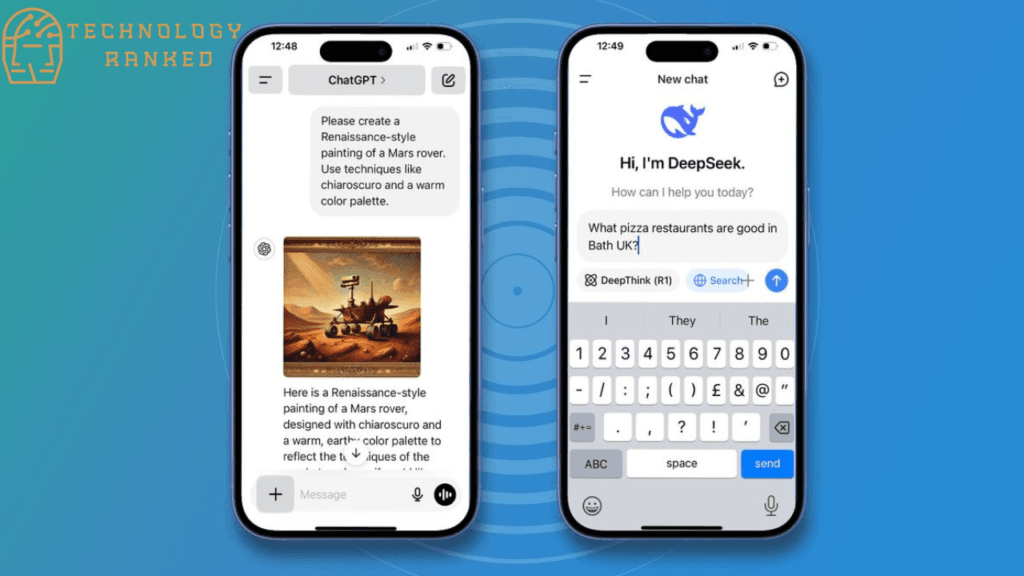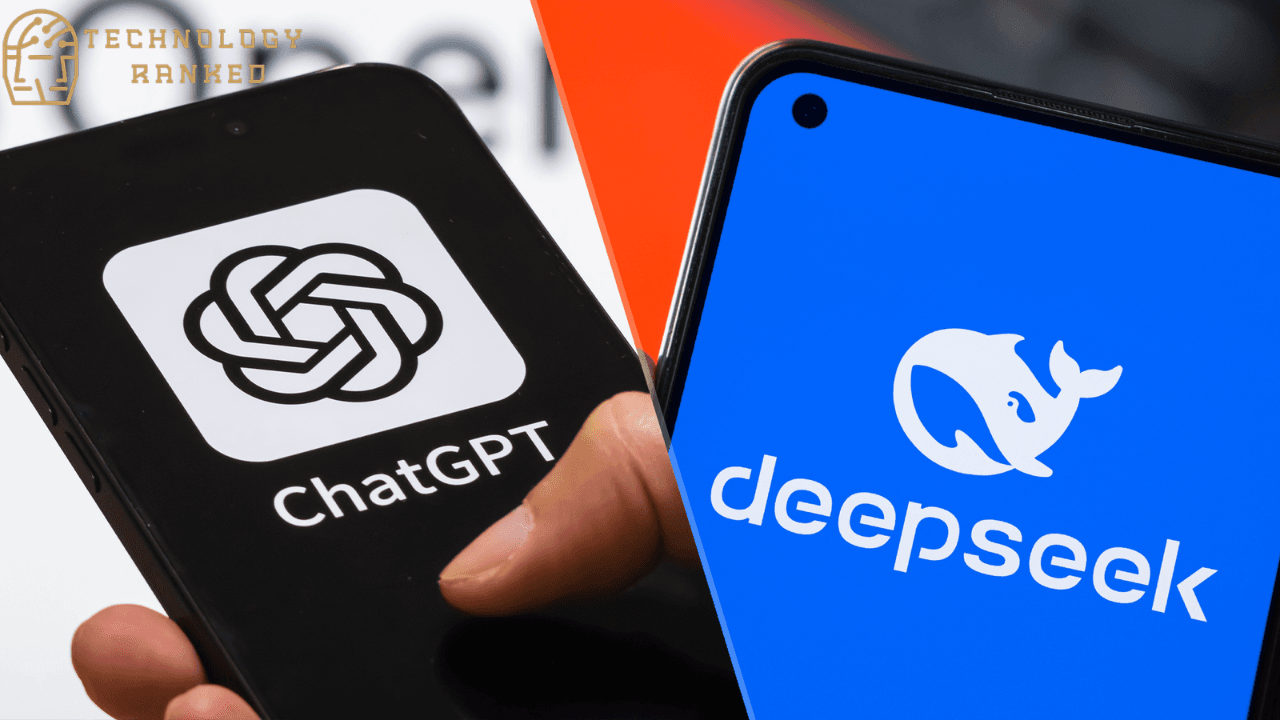Contents
ToggleDeepSeek and ChatGPT represent advanced AI language models developed by organizations in China and the U.S., respectively. This comparison explores their technical foundations, performance, applications, and ethical approaches to aid users in understanding their distinct strengths and use cases.
ChatGPT-01 Model
ChatGPT and DeepSeek R1 is an advanced AI model designed for enhanced conversational abilities, improved contextual understanding, and more accurate responses. Built on OpenAI’s latest architecture, it integrates cutting-edge natural language processing (NLP) techniques to deliver high-quality, context-aware interactions.
Key improvements in ChatGPT-01 include better reasoning, reduced biases, and a more efficient response generation system. It supports a wide range of applications, from professional writing assistance to technical problem-solving, making it a versatile tool for businesses and individuals alike.
DeepSeek R1 Model
DeepSeek and ChatGPT is a cutting-edge AI model developed by DeepSeek, designed to deliver advanced reasoning, natural language understanding, and enhanced problem-solving capabilities. Built with a highly optimized transformer architecture, DeepSeek R1 excels in generating accurate, context-aware responses across various domains, including programming, research, and professional writing.

Performance and Capabilities
| Aspect | ChatGPT-4o | DeepSeek-R1 |
|---|---|---|
| Multilingual Support | 50+ languages (strong in English) | Primarily Chinese, limited English |
| Multimodal Skills | Text, image, audio input/output | Text-focused, no public multimodal features |
| Speed | Ultra-low latency (~232ms avg response) | Optimized for batch processing in enterprises |
| Domain Expertise | General knowledge, coding, creativity | Specialized in Chinese finance, law, education |
| Safety/Alignment | RLHF + constitutional AI principles | Compliant with Chinese laws and censorship norms |
Applications
- ChatGPT-4o:
- Real-time translation, voice assistants, customer support, content creation, and education.
- Integrated into apps like ChatGPT Desktop, Copilot, and third-party APIs.
- DeepSeek-R1:
- Chinese enterprise workflows: automated report generation, legal document analysis, AI tutors.
- Tailored for industries requiring strict compliance (e.g., banking, healthcare in China).
5. Accessibility
- ChatGPT-4o:
- Free tier with limited features; Plus subscribers get priority access.
- API available for developers (costs based on token usage).
- DeepSeek-R1:
- Primarily B2B via enterprise partnerships; limited public access outside China.
- Requires compliance with Chinese data localization laws.
6. Key Strengths
- Choose ChatGPT-4o if:
- You need multimodal, real-time interaction (voice/image support).
- Your use case is global, English-centric, or creative (e.g., coding, storytelling).
- Choose DeepSeek-R1 if:
- You operate in China and require Chinese-language specialization (e.g., legal/financial docs).
- Compliance with Chinese regulations and industry-specific tuning are critical.
7. Limitations
Less transparent development and benchmarking data.
ChatGPT-4o:
Struggles with highly technical Chinese terminology.
DeepSeek-R1:
Limited customization for industry-specific needs.
Weak multilingual/multimodal support compared to GPT-4o.
To address your query about an “American exchange loss over $2 billion” in the context of AI development or corporate performance, here’s an analysis of potential interpretations and their relevance to the DeepSeek and ChatGPT comparison:
Possible Interpretations and Context
- Hypothetical Financial Loss in AI Development
- If referring to losses by U.S. companies like OpenAI (developer of ChatGPT), there is no publicly reported $2 billion loss tied directly to AI model development.
- OpenAI operates with significant funding from Microsoft (over $10 billion invested), focusing on long-term R&D despite high operational costs. Losses here are strategic and offset by partnerships.
- Stock Market or Crypto Exchange Losses
- A 2billionlosscouldrelatetounrelatedfinancialmarkets(e.g.,cryptoexchangeslikeFTX,whichcollapsedin2022with2billionlosscouldrelatetounrelatedfinancialmarkets(e.g.,cryptoexchangeslikeFTX,whichcollapsedin2022with8 billion in losses). This is not directly tied to AI models like ChatGPT or DeepSeek.
- Economic Impact of U.S.-China AI Competition
- The U.S. and China are investing heavily in AI dominance. While China’s DeepSeek targets domestic markets, U.S. models like ChatGPT prioritize global reach.
- A hypothetical “$2 billion loss” for America might symbolize opportunity costs if Chinese AI firms outcompete U.S. companies in key sectors (e.g., cloud services, enterprise software).
Relevance to DeepSeek vs. ChatGPT
- DeepSeek-R1: Focused on capturing China’s enterprise market (e.g., finance, education), reducing reliance on U.S. AI solutions. This could indirectly challenge American tech exports.
- ChatGPT-4o: OpenAI’s global expansion faces challenges like regulatory scrutiny in the EU and competition from regional players like DeepSeek. However, no direct $2 billion loss is documented.
Conclusion
While there is no verified $2 billion loss tied to DeepSeek and ChatGPT or U.S. exchanges in the AI space, the broader U.S.-China tech rivalry involves significant financial stakes. For instance:
- U.S. sanctions on Chinese tech firms (e.g., Huawei) have reshaped global supply chains.
- Chinese AI advancements (e.g., DeepSeek) could pressure American companies in Asian markets, but quantifying this as a “$2 billion loss” would require specific context.
If referencing a specific event, please clarify (e.g., stock market crash, corporate earnings report). Otherwise, the AI competition remains a strategic battleground with long-term economic implications rather than a direct financial loss.
Final Verdict comparing DeepSeek-R1 and ChatGPT-4o
Final Verdict: DeepSeek-R1 vs. ChatGPT-4o
| Factor | ChatGPT-4o (OpenAI) | DeepSeek-R1 (DeepSeek Inc.) |
|---|---|---|
| Strengths | ✅ Multimodal fluency (text, image, audio). ✅ Global reach (50+ languages). ✅ Real-time interaction (low latency). ✅ Creativity & coding support. | ✅ Superior Chinese NLP (semantic understanding). ✅ Industry-specific tuning (finance, law, education). ✅ Regulatory compliance (Chinese laws). ✅ Enterprise efficiency. |
| Weaknesses | ❌ Limited expertise in Chinese technical domains. ❌ Higher costs for API/enterprise use. ❌ Struggles with strict regional compliance (e.g., China). | ❌ No multimodal features (text-only). ❌ Weak multilingual support. ❌ Limited transparency/benchmarks. |
| Ideal For | – Global businesses needing multimodal AI. – English-centric tasks (content, coding). – Startups/developers prioritizing creativity. | – Chinese enterprises in regulated industries. – Tasks requiring localized Chinese expertise. – Compliance-heavy workflows in China. |
| Avoid If | – Your focus is China-specific compliance. – You need deep expertise in Chinese legal/financial jargon. | – You require multimodal (voice/image) features. – Your audience is global/multilingual. |
Key Decision Factors
- Language & Region:
- Choose ChatGPT-4o for global/English tasks.
- Choose DeepSeek-R1 for Chinese-dominated workflows.
- Industry Needs:
- ChatGPT-4o: Best for general creativity, coding, and content generation.
- DeepSeek-R1: Dominates in Chinese finance, law, education, and healthcare.
- Compliance:
- DeepSeek-R1 aligns with Chinese regulations (data localization, censorship).
- ChatGPT-4o faces restrictions in China and other regulated markets.
- Cost & Accessibility:
- ChatGPT-4o: Transparent pricing (free/paid tiers + API) but costly at scale.
- DeepSeek-R1: Likely B2B pricing (less public info) but optimized for Chinese enterprise budgets.
Final Recommendation
- For Global Teams: ChatGPT-4o is unmatched in versatility, speed, and multimodal innovation.
- For China-Focused Enterprises: DeepSeek-R1 is the pragmatic choice for compliance and localized performance.
The future of AI is context-specific: While OpenAI leads in global R&D, DeepSeek exemplifies how regional players can dominate niche markets. Stay updated—both models will evolve rapidly! 🚀
Faqs About DeepSeek vs ChatGPT
ChatGPT-4o: OpenAI’s latest multimodal AI model (text, image, audio) optimized for real-time interaction and global use.
DeepSeek-R1: A Chinese-language-focused AI model by DeepSeek Inc., specialized for enterprise workflows in regulated industries (finance, law, education).
ChatGPT-4o: Supports 50+ languages (strongest in English) with basic proficiency in Chinese.
DeepSeek-R1: Excels in Chinese (technical, legal, and industry jargon) but has limited multilingual capabilities.
DeepSeek-R1 wins for:
Compliance with Chinese regulations (censorship, data laws).
Understanding nuanced Chinese terminology (e.g., legal contracts).
ChatGPT-4o struggles with:
Chinese technical domains and strict regulatory alignment.
Yes: ChatGPT-4o processes text, images, and audio (e.g., voice conversations, visual analysis).
DeepSeek-R1: Text-only (no public multimodal features).
ChatGPT-4o: Built for low latency (~232ms average response time), ideal for chatbots or live translation.
DeepSeek-R1: Optimized for batch processing (e.g., document analysis), not real-time speed.



